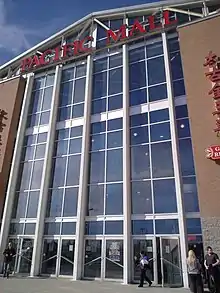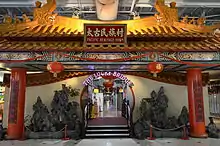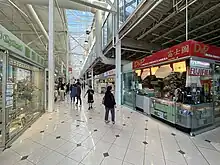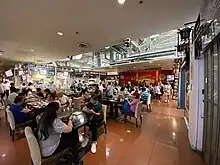 Aerial view of Pacific Mall | |||||||||||
| Location | Markham, Ontario, Canada | ||||||||||
|---|---|---|---|---|---|---|---|---|---|---|---|
| Coordinates | 43°49′35″N 79°18′23″W / 43.82639°N 79.30639°W | ||||||||||
| Opening date | 1996[1] or 1997[2] | ||||||||||
| Developer | The Torgan Group | ||||||||||
| Owner | Pacific Mall Condominium Corporation | ||||||||||
| No. of stores and services | 450[3] | ||||||||||
| Total retail floor area | 270,000 sq ft (25,084 m2) | ||||||||||
| No. of floors | 3 | ||||||||||
| Public transit access | |||||||||||
| Chinese name | |||||||||||
| Traditional Chinese | 太古廣場 | ||||||||||
| Simplified Chinese | 太古广场 | ||||||||||
| |||||||||||

Pacific Mall is an Asian shopping mall in Markham, Ontario, Canada. It is the largest indoor Asian shopping mall in North America and has been reported as the largest Asian shopping mall in the Western world. The mall is located on the northeast corner of Steeles Avenue and Kennedy Road, along the city limits with Toronto. Opened in the mid-1990s amid a period of significant Chinese immigration to Canada, the mall operates as a condominium corporation with 450 individual units. The mall also includes Heritage Town, a food court and market that functions as a notable tourist destination in the Greater Toronto Area.
The Remington Centre, a proposed shopping mall first announced in 2005, would occupy the site formerly held by Market Village, a now-defunct mall adjacent to Pacific Mall. The expansion would see the construction of a structure that would bring the combined size of the malls to 1,000,000 square feet (90,000 m2), though the project has faced numerous delays.
Pacific Mall is further noted as a location for the sale of counterfeit goods; stores in Pacific Mall have been raided multiple times by the Royal Canadian Mounted Police, and in 2018 the mall was listed as a notorious market by the Office of the United States Trade Representative.
History
Prior use
Pacific Mall is built on the site formerly occupied by Cullen Country Barns, a farm-themed complex opened in 1983 that housed shops, a theatre, and restaurants.[4] The complex was established by Len Cullen, the founder of Cullen Gardens and Miniature Village in Whitby, Ontario, and consisted of two barn wings with gambrel roofs and a concrete silo. None were historic structures dating back to the time when the site was a working farm, but they were acquired by Cullen and moved from Pickering, Ontario, to Markham in the 1970s.[5] A fire damaged part of the complex in 1988,[6] and it was demolished in 1994; some portions of the former Market Village, a shopping complex adjacent to Pacific Mall, mimicked the Cullen complex.[7]
Development

Planning for Pacific Mall began in the late 1980s amid the formation of Chinese immigrant communities in suburban Toronto and a flourishing of ethnic malls in Markham, Richmond Hill, and Scarborough.[8][9] The mall was planned and constructed amid the so-called "Hong Kong Tide" of the 1980s and 1990s, which saw an increase in immigration to Canada by highly educated, skilled migrants from Hong Kong who were frequently wealthy entrepreneurs and investors.[10] This immigration was influenced by a range of factors, notably the handover of Hong Kong, and new Canadian open-door immigration policies that recruited based on merit rather than national origin.[11][12] The passage of the Investment Canada Act, which sought to direct business migrants and foreign capital into Canada, is also noted as a factor.[13] Of additional note is the implementation of the Canadian Immigrant Investor Program (CANIIP), which granted landed immigrant status to individuals with least CAD$500,000 in wealth who agreed to invest $250,000 in Canadian business ventures.[14] As a result of this immigration, Markham's ethnic Chinese population rose 15 percent in 1995, resulting in nearly 30 percent of Markham's population being of Chinese origin;[15] by 1999, there would be a total of 58 Asian shopping malls in Markham, Richmond Hill, and Scarborough.[11]
A large-scale, indoor Asian mall to be built on the former site of Cullen Country Barns was formally proposed in 1993 by Torgan Group, an Israeli-Canadian development company,[4][16] with the Fairchild Group as a partner.[17] The mall would operate as a condominium corporation, where shop units are owned by individuals who determine the store's inventory and business hours, and can sell the unit at will. The developers of Pacific Mall claimed they were the first mall in North America to use this business model,[18] though Pacific Mall was preceded by the condominium mall Chinatown Centre in West Chinatown, Toronto, which opened in 1989.[19]
The mall's construction was opposed by some long-term residents of Markham,[20] and was delayed numerous times from 1993 to 1996.[21] Concerns were raised by Markham City Council over the impact the mall would have on parking and traffic volume, the style of the building that would replace Cullen Country Barns, and challenges in dealing with multiple owners in a condo-style mall.[4][16] The Council commissioned an independent study on retail condominiums by John Winter and Associates, which concluded that retail condos are a positive means of diversifying developments.[22] Pacific Mall's application underwent a nine-month review,[23] with a building permit granted in May 1995.[22]
Historian Erica Allen-Kim argues that Pacific Mall was "a weathervane for Markham's ongoing transformation from a rural township to an ethnoburb."[24] Then-deputy mayor of Markham Carole Bell received criticism for her statement that "everything's going Chinese" in response to the proliferation of ethnic malls.[11][25] She attempted to implement by-laws that would have forbid the rezoning of industrial areas for retail condominiums and made English-language signs mandatory on all structures.[24] Then-mayor of Markham Don Cousens formed an advisory council of eleven Markham residents and three members of council to "address associated multicultural issues affecting planning decisions."[22]
Opening and continued operation

Sources report Pacific Mall as opening either in 1996[1] or 1997.[2] Its Cantonese name, "太古廣場" (Tai Gu Gwong Cheung), is derived from Pacific Place in Hong Kong. At the time of its opening, Pacific Mall was the only mall of any kind of its scale in Scarborough and Markham.[26] The mall's 715 retail condos were presold by 1993 for an average of $200 per square foot, and were priced from $59,800 to $249,800.[23] A majority of condo buyers originated from Hong Kong, where Pacific Mall units were advertised extensively;[23] many investors purchased units in Pacific Mall in order to fulfill the $250,000 investment requirement of CANIIP.[18]

After business at the mall was initially slow, half of the unused second floor (which is owned and operated by Torgan Group, rather than condo leasees[27]) was renovated in 1999 into Heritage Town, a food court and market that contains approximately 100 vendors.[26] Aimed at attracting tourists and non-Chinese customers,[27] Torgan Group commissioned artists and sculptors in China to make custom decorations for Heritage Town, including a large bas-relief of a dragon, 300 lanterns, an emperor's chair, a wood-work bridge, and terracotta soldiers.[26] Heritage Town was successful in attracting additional business, prompting the mall to seek and be awarded designation as a Canadian Tourist Attraction. As such, Pacific Mall is exempt from the Retail Business Holiday Act and is open year-round, including statutory holidays.[28][29]
Today, Pacific Mall remains a major destination for tourism in Canada, and promotes itself through pamphlets at airports and tourist information centers in major North American cities.[26] As demographics of Chinese migrants to Canada shifted in 2010s, and immigrants from mainland China form a greater proportion of Chinese immigrants, many businesses at Pacific Mall have opted to hire salespeople fluent in Cantonese, Mandarin, and English.[30] Though stores in the mall are noted for having relatively high turnover,[31] many stores continue to be operated by their initial Hong Kong-originating owners.[32]
Features
Stores

Pacific Mall is the largest indoor Asian shopping mall in North America[3] and has been reported as the largest Asian shopping mall in the Western world.[33] The mall is surrounded by an existing shopping plaza, including remnants of the former Market Village, which collectively encompass over 500 stores and 1,500 indoor and outdoor parking spaces.[34] Stores range in size from 300 to 800 square feet (28 to 74 m2) and sell a wide variety of goods, including traditional Chinese clothing, contemporary fashion, jewelry, herbal medicine, tea, electronics, mobile phones, ornaments, food, and printed material such as Chinese books, magazines and newspapers.[20][34][35][36] A "diminishing number"[36] of stores sell both legitimate and pirated CDs and DVDs; the decline in the sale of these goods can be attributed to regular police raids and the growing ubiquity of this material online.[36]
As a condominium corporation, store owners elect representatives to form a management board, which oversees the operation of the mall.[18]
Design


Pacific Mall was designed by Wallman Clewes Bergman Architects,[37] who built the structure in a combination of red brick, steel beams, and glass.[18] The firm sought to create a "fabulous transparent building as different as possible from its surrounding,"[34] but rather than emulate Chinese architecture, sought to create a building that complimented Markham's suburban architecture.[34] The mall's market-style interior with exposed roof trusses, pipes, and roof decks is described as "good representation of shed typology that is characterized by mass production, cost efficiency, and fast construction."[34]
The mall has two floors and a basement level that leads to an underground parking lot. The hallways of the main floor are arranged in a grid, with each hallway given a street name: hallways running north–south are named after streets in Hong Kong, such as Hennessy Avenue, Hollywood Avenue, Pacific Avenue, Queen's Avenue, and Nathan Avenue, while hallways running east–west are numerical with numbers associated with affluence and luck in Cantonese, such as 218th Street and 188th Street.[34] The centre of the mall contains an indoor courtyard with a cathedral dome ceiling and stage that hosts cultural programs and trade fairs.[26] The second floor contains a food court, entertainment centre, medical offices, additional shops, and Heritage Town.[26]
Future expansion
On June 15, 2005, Pacific Mall and Market Village announced a 400,000-square-foot (37,000-square-metre) expansion that would see the construction of additional retail space, a luxury hotel, condominiums, and a multi-level parking structure that would bring the combined size of the malls to 1,000,000 square feet (90,000 m2).[38] In 2009, the developers announced they would instead demolish Market Village and construct a new adjoining mall, the Remington Centre.[39] The project has faced numerous delays;[40][41] while the expansion plan was endorsed by Markham City Council in 2011, it requires additional approvals from the municipal government of Toronto and a majority of the ownership of Pacific Mall, 40 percent of which is composed of individual retailers.[42]
Controversies
Counterfeit merchandise
Pacific Mall is noted for its sale of counterfeit and pirated goods, including video games, movies, music, electronic devices, cosmetics, apparel, and fragrances.[43] In January 2018, the mall was listed as a notorious market by the Office of the United States Trade Representative,[44] which noted that vendors in Pacific Mall “operate largely with impunity” despite requests for assistance from law enforcement.[45][46] Pacific Mall management responded that they were "deeply disturbed" by the designation, and stated that they would give warnings to vendors who sold illicit goods.[47]
The mall has been raided multiple times by the Royal Canadian Mounted Police (RCMP). On May 5, 2005, the RCMP seized over $800,000 worth of counterfeit goods, including 30,000 DVDs and 3,000 video games.[48] On July 13, 2006, over 1,000 copies of pirated video game software were seized.[49] On May 6, 2009, over 49,000 DVDs, 217 DVD burners, and over 100,000 blank DVDs were seized; four individuals were charged with multiple counts under the Copyright Act.[50] On December 3, 2012, over $3 million worth of counterfeit goods were seized from Pacific Mall as a part of "Project Consumer Safety."[51][52] On June 27, 2018, seven search warrants were executed for stores in Pacific Mall, resulting in the seizure of clothing, handbags, and cell phone accessories;[53] eight individuals were charged with knowingly or recklessly making false representation to the public and selling or distributing goods in association with a trademark on May 28, 2019 as a result of the seizures and subsequent police investigation.[54]
In March 2009, the RCMP teamed with the York Regional Police and commenced uniformed foot patrols in shopping malls located in south Markham, including Pacific Mall, in an effort to curb the sale of counterfeit items.[55][56]
Traffic congestion

Pacific Mall is a major contributor to traffic congestion in southern Markham.[57] The surrounding road infrastructure, which was built only to accommodate Market Village, is insufficient in accommodating the large volume of vehicle traffic that the mall receives. Pacific Mall also suffers from a parking shortage; though the mall contains an underground garage facility, no additional parking has been added since the mall's opening.[58][59]
February 2009 shooting
On February 20, 2009, Kit Chen "Daniel" Cheong, 26, was shot and killed at the XSITE Cell Phones store in Pacific Mall.[60][61] The primary suspect in the case was identified as Bryan Valentine Gardner from security camera footage; Gardner was arrested in London, Ontario, on September 2, 2010, 18 months after the incident.[60] On August 28, 2013, Gardner was sentenced to life in prison, with no chance of parole until 2026.[62]
Transportation access
Pacific Mall is located at the corner of Steeles Avenue and Kennedy Road in Markham, along the city limits with Toronto. It is served by both the Toronto Transit Commission (routes 43 Kennedy and 53 Steeles East) and York Region Transit (Route 8 Kennedy) buses, and is located within walking distance of the Milliken GO Station, which connects to the Stouffville line. The two street entrances to the mall are located at Redlea Avenue and Clayton Drive.[63]
See also
References
- 1 2 Sources giving 1996 include:
- Chan, Arlene (2013). The Chinese Community in Toronto: Then and Now. Toronto: Dundurn Press. p. 120. ISBN 978-1-4597-0769-6.
Next to Market Village is the Pacific Mall, which opened in 1996 as North America's largest Chinese indoor mall.
- Leung, Ho Hon; Lau, Raymond (2009). Leung, Ho Hon; Handley, Matthew; Compton, Robert; Haley, Brian (eds.). "Making of Pacific Mall: Chinese Identity through Architecture in Canada". Imagining Globalization: Language, Identities, and Boundaries. Palgrave Macmillan: 117.
The Pacific Mall opened in 1996.
- Leung, Ho Hon (2017). Wong, Lloyd L. (ed.). "The Practice of Transnationalism in Pacific Mall". Trans-Pacific Mobilities: The Chinese and Canada. Vancouver: UBC Press: 306.
...opened in 1996...
- Chan, Arlene (2013). The Chinese Community in Toronto: Then and Now. Toronto: Dundurn Press. p. 120. ISBN 978-1-4597-0769-6.
- 1 2 Sources giving 1997 include:
- Allen-Kim, Erica (2017). Sandoval-Strausz, A.K.; Kwak, Nancy (eds.). "Condos in the Mall: Suburban Transnational Typological Transformations in Markham, Ontario". Making Cities Global: The Transnational Turn in Urban History. University of Pennsylvania Press: 145.
...opened in 1997, the year in which immigration from Hong Kong and Taiwan peaked...
- Bascaramurty, Dakshana (June 15, 2012). "The rise and fall of the ethnic mall". Globe and Mail. Retrieved October 21, 2019.
While Markham's Pacific Mall, opened in 1997...
- Roth, Mark. "Canada's most diverse city". Pittsburgh Post-Gazette. Retrieved October 23, 2019.
Edwin Wong has operated his Chinese herbal store at Pacific Mall since it opened in 1997.
- Allen-Kim, Erica (2017). Sandoval-Strausz, A.K.; Kwak, Nancy (eds.). "Condos in the Mall: Suburban Transnational Typological Transformations in Markham, Ontario". Making Cities Global: The Transnational Turn in Urban History. University of Pennsylvania Press: 145.
- 1 2 "Pacific Mall". Experience York Region. Regional Municipality of York. August 22, 2012. Retrieved November 18, 2019.
- 1 2 3 Allen-Kim 2017, p. 143.
- ↑ "Len Cullen was visionary industry pioneer". Landscape Ontario Horticultural Trades Association. March 30, 2016. Retrieved October 20, 2019.
- ↑ Irish, Paul (October 18, 1998). "Frontal attack". Getty Images. Retrieved October 20, 2019.
- ↑ Low, Jeff (February 22, 2013). "Then and Now: Cullen Country Barns and Pacific Mall". Urban Toronto. Retrieved October 21, 2019.
- ↑ Leung & Lau 2009, p. 14.
- ↑ Leung & Lau 2009, p. 112.
- ↑ Chan 2013, p. 113.
- 1 2 3 Wong, Jan (November 6, 2004). "Not made in China". The Globe and Mail. Retrieved October 22, 2019.
- ↑ Chan 2013, p. 112.
- ↑ Leung & Lau 2009, p. 113.
- ↑ Allen-Kim 2017, p. 137.
- ↑ Allen-Kim 2017, p. 139.
- 1 2 Leung & Lau 2009, p. 118.
- ↑ Ley, David (2011). Millionaire Migrants: Trans-Pacific Life Lines. John Wiley & Sons. ISBN 9781444399530.
- 1 2 3 4 Leung & Lau 2009, p. 115.
- ↑ Allen-Kim 2017, p. 138.
- 1 2 Chan 2013, p. 120.
- ↑ Allen-Kim 2017, p. 141.
- 1 2 3 Allen-Kim 2017, p. 144.
- 1 2 3 Allen-Kim 2017, p. 145.
- 1 2 Allen-Kim 2017, p. 133.
- ↑ Lee, Matt (July 5, 2010). "Ethnic Relations I: The Evolution of Steeles and Kennedy". Green Beam City. Archived from the original on May 22, 2010. Retrieved October 22, 2019.
- 1 2 3 4 5 6 Leung & Lau 2009, p. 117.
- 1 2 Allen-Kim 2017, p. 146.
- ↑ Consiglio, Alex (December 25, 2012). "No stopping shopping at Pacific Mall on Christmas". Toronto Star. Retrieved October 20, 2019.
- ↑ "Markham mall granted holiday exemption". YorkRegion.com. May 18, 2012. Retrieved October 20, 2019.
- ↑ Leung 2017, p. 311.
- ↑ Allen-Kim 2017, p. 150.
- ↑ Leung 2017, p. 312.
- ↑ Casey, Liam (May 28, 2019). "Eight people charged, thousands of alleged fake goods seized from Pacific Mall". CTV News. The Canadian Press. Retrieved October 21, 2019.
- 1 2 3 4 5 6 Leung & Lau 2009, p. 116.
- ↑ Leung 2017, p. 310.
- 1 2 3 Leung 2017, p. 308.
- ↑ "BCC Ruling No. 95-40-460". Ontario Ministry of Municipal Affairs and Housing. August 24, 1995. Retrieved October 21, 2019.
- ↑ "Corporate Markham In The News". Markham's Corporate and Community Information Online. June 15, 2005. Archived from the original on August 28, 2005. Retrieved March 5, 2020.
- ↑ Wong, Tony (June 19, 2009). "A huge gamble on Markham Asian mall". Toronto Star. Retrieved June 19, 2009.
- ↑ Bascaramurty, Dakshana (June 15, 2012). "The rise and fall of the ethnic mall". Globe and Mail. Retrieved October 21, 2019.
- ↑ Susilo, Darren (July 30, 2012). "The Remington Centre will not be a strip club". blogTO. Retrieved May 30, 2018.
- ↑ Persico, Amanda (February 17, 2016). "Lack of agreement stalls Markham retail hub's redevelopment". YorkRegion.com. Retrieved May 30, 2018.
- ↑ "Toronto-area mall one of world's most notorious sources of counterfeit goods: U.S." CTV News. January 12, 2018.
- ↑ "Pacific Mall is one of world's most notorious sources of counterfeit goods: U.S." CP24.com. January 12, 2018.
- ↑ "2017 Notorious Markets List Spotlights Global Piracy and Counterfeiting, Defends American Products and Workers" (Press release). Office of the United States Trade Representative. January 12, 2018.
- ↑ "2017 Out-of-Cycle Review of Notorious Markets" (PDF). Office of the United States Trade Representative. January 11, 2018.
- ↑ "Pacific Mall 'deeply disturbed' to learn it is 'notorious market' for counterfeit goods". CP24.com. February 20, 2018.
- ↑ Prashad, Sharda (May 5, 2005). "Pirated DVDs seized at mall". The Toronto Star.
- ↑ "Entertainment Software Industry Applauds RCMP Anti-piracy Action Against Pacific Mall Piracy". ESA. 2006. Archived from the original on August 18, 2006. Retrieved July 31, 2006.
- ↑ CNW Newswire (May 6, 2009). "RCMP Seize 1000s of Pirated DVD's". CNW Group. Archived from the original on June 9, 2011. Retrieved October 20, 2019.
- ↑ "Police seize more than $3M in counterfeit goods". CTV News. December 3, 2012. Retrieved October 20, 2019.
- ↑ "Pacific Mall raid protects us shoppers, right?". blogTO. 2009. Retrieved May 6, 2009.
- ↑ "Police raid Pacific Mall shops looking for counterfeit goods". CNW Group. 2012. Retrieved July 7, 2018.
- ↑ Naidu-Ghelani, Rajeshni (May 28, 2019). "8 people charged in year-long Pacific Mall investigation over counterfeit goods". Global News. Retrieved October 22, 2019.
- ↑ "打假專家出馬 今搜名牌A貨 突搜萬錦廣場 涉售盜版碟3店接警告". Ming Pao Canada (in Chinese). Archived from the original on March 22, 2009. Retrieved October 20, 2019.
- ↑ "開即掃 趕絕售盜版光碟店 警方派員長駐約克區商場半年". Sing Tao Daily (in Chinese). March 17, 2009. Archived from the original on July 19, 2011. Retrieved October 20, 2019.
- ↑ "Scarborough Community Council Denies Bid to Stop Shopping Mall Expansion". The Scarborough Mirror. October 2, 2007.
- ↑ Hsieh, L.H. Tiffany (September 20, 2010). "Markham Malls Unveiled". The Remington Group. Markham Economist Sun. Archived from the original on February 28, 2011. Retrieved October 20, 2019.
- ↑ "Pacific Mall 2 planned". YorkRegion.com. March 15, 2010. Retrieved October 20, 2019.
- 1 2 Lamberti, Rob (September 2, 2010). "Arrest in Pacific Mall murder". Toronto Sun. Archived from the original on September 3, 2010. Retrieved October 20, 2019.
- ↑ Commisso, Christina (February 23, 2009). "Slaying suspect caught on video". Toronto Star. Retrieved October 20, 2019.
- ↑ Moore, James (August 28, 2013). "Accused pleads guilty in Pacific Mall murder". Newstalk 1010. Archived from the original on September 1, 2013. Retrieved October 20, 2019.
- ↑ "Directions". Pacific Mall. Retrieved October 22, 2019.
Bibliography
- Allen-Kim, Erica (2017). Sandoval-Strausz, A.K.; Kwak, Nancy (eds.). "Condos in the Mall: Suburban Transnational Typological Transformations in Markham, Ontario". Making Cities Global: The Transnational Turn in Urban History. University of Pennsylvania Press: 133–150.
- Chan, Arlene (2013). The Chinese Community in Toronto: Then and Now. Toronto: Dundurn Press. ISBN 978-1-4597-0769-6.
- Leung, Ho Hon (2017). Wong, Lloyd L. (ed.). "The Practice of Transnationalism in Pacific Mall". Trans-Pacific Mobilities: The Chinese and Canada. Vancouver: UBC Press: 302–314.
- Leung, Ho Hon; Lau, Raymond (2009). Leung, Ho Hon; Handley, Matthew; Compton, Robert; Haley, Brian (eds.). "Making of Pacific Mall: Chinese Identity through Architecture in Canada". Imagining Globalization: Language, Identities, and Boundaries. Palgrave Macmillan: 107–125. doi:10.1057/9780230101586_7.